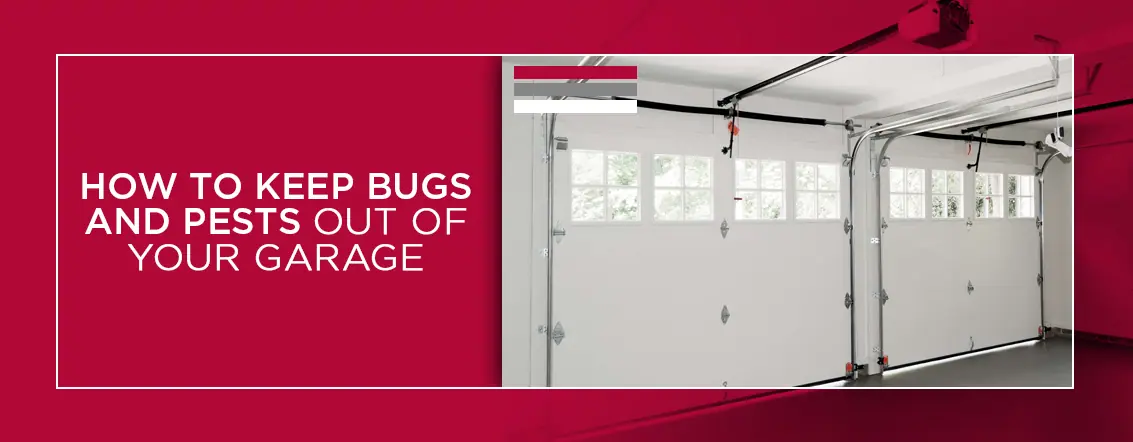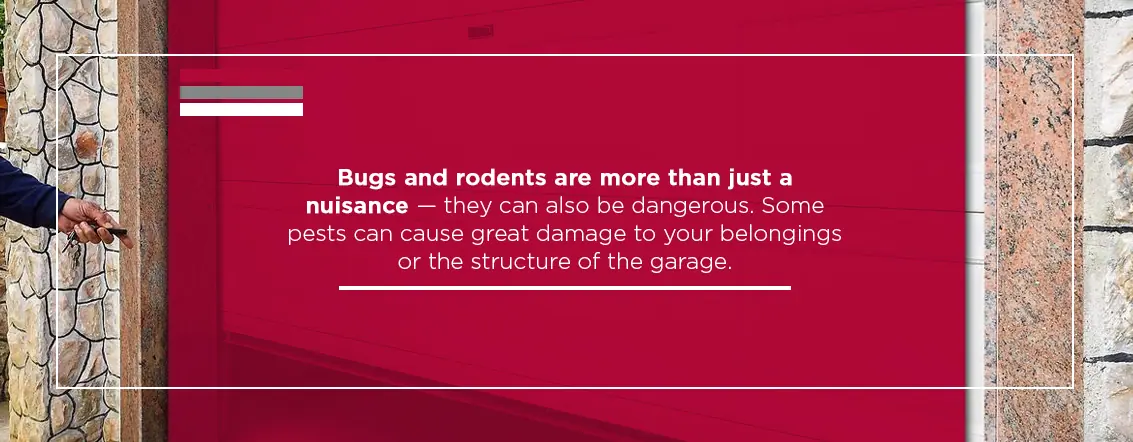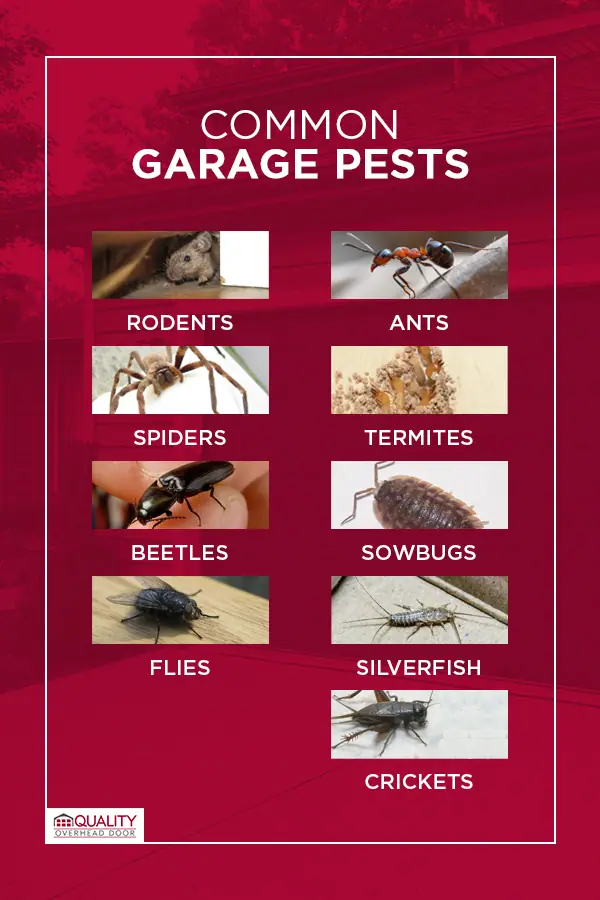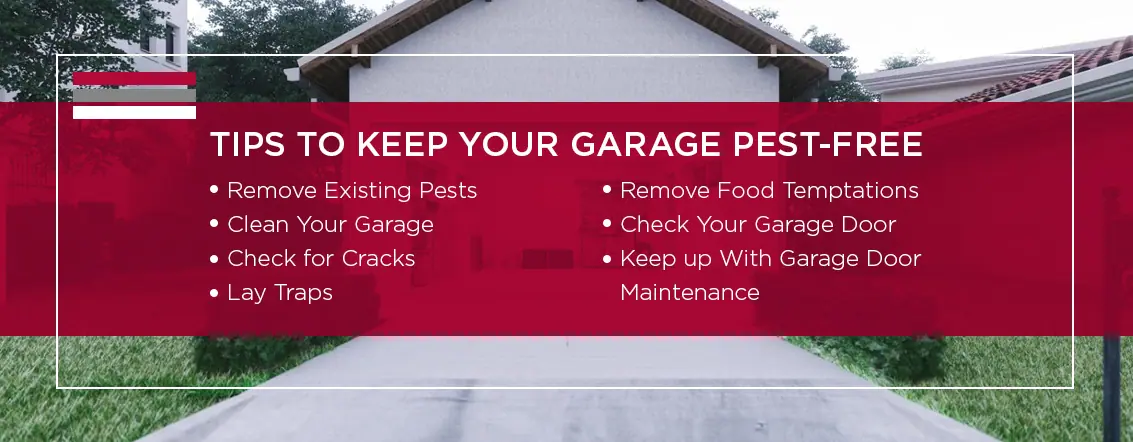According to the American Housing Survey, nearly 80,000 Americans have a garage. Garages are a great asset to have at home — they keep your vehicles safe, provide additional storage and can be used as a workshop or hobby room. Unfortunately, many garage owners struggle with an unwanted pest infestation, including bugs and rodents. Once these pests make their way into a garage, they can destroy your belongings, damage the structural integrity of the room and may make their way into your main living space if not stopped. If you are suffering from a garage pest infestation, here are some steps you can take.
Why Pests Love Garages
Most people have encountered an insect, rodent or other pest in their garage at one point or another. Have you ever wondered why bugs seem to love garages so much? Chances are, it’s for one or more of the following reasons:
- Garages offer protection: Your garage offers bugs and pests protection from dangers like summer heat, frigid winters, severe or inclement weather, natural predators and more. Pests may also seek protective shelter in your garage if their outdoor home has been destroyed.
- They simulate a bug’s natural environment: Many bugs are drawn to garages because they remind them of their natural habitat: moist, dark and warm with plenty of materials and debris to burrow and nest in.
- Pests are attracted to smells: Your garage can be a source of many tempting smells for bugs and pests, including sweet scents from food products, plants, spillage, stored grains, animal food or birdseed. Some pests are attracted to less pleasing smells, like garbage, blood and sweat.
Why It’s Important to Eliminate Pests in Your Garage
Bugs and rodents are more than just a nuisance — they can also be dangerous. Some pests can cause great damage to your belongings or the structure of the garage. They can even use the garage as an easy way to enter your home. Some pests, like rodents and flies, can also spread harmful bacteria and diseases. For these reasons, the prompt elimination of pests is crucial.
Common Garage Pests
There are several different species of bugs or types of pests that can pose a threat to you and your garage. However, the following are among the most common garage bugs and pests.
1. Rodents
According to one survey, 37% of Americans saw a rodent in their home in 2017. Of that 37%, 39% saw the rodent in their garage. Rodents include mice and rats and are among the most dangerous garage pests because they can spread fleas and mites, chew and burrow into your belongings and seldom arrive alone. According to the Centers for Disease Control and Prevention (CDC), rodents can also spread over 35 diseases worldwide.
2. Ants
Identifying the ant in your garage is the first step to eradicating the issue. The three types of ants most commonly found inside homes and garages are:
- Carpenter ants: Carpenter ants excavate wood and nest inside structures, which can cause lasting damage to areas in your garage, like shelving.
- Odorous house ants: These ants do not necessarily pose a threat to you or your home, but colonies nest under debris and wood, which many homeowners find bothersome.
- Pavement ants: Pavement ants have a stinger and often feed on food items. They mine into the pavement and concrete, including garage floors.
3. Spiders
Spiders often retreat into homes and garages in the late summer and early fall, as temperatures begin to shift outdoors. Numerous different types of spiders can enter your garage through cracks or when your garage door is open. They build unsightly webs on the ground and in ceiling corners. Although most household spiders do not bite, most homeowners do not want an infestation on their hands.
4. Termites
According to the CDC, termites are among the most destructive household pests in America and are responsible for billions of dollars of damage per year. Termites break down and consume more than wood — they are are also often responsible for damage to cardboard boxes, fiberboard, paper products, furniture and more. They usually enter your garage at vulnerable areas, like where wood siding meets the ground or where moisture collects near your foundation.
5. Beetles
There are roughly 30,000 different types of known beetles in the United States. Beetles enter your house or garage through packages, firewood or other natural materials stored indoors or even potted plants. Though beetles are harmless for the most part, they can pose a significant threat to any stored food products you keep in your garage, including grains, dairy, meats, boxes of cereal and more. They have also been known to eat fabric, wood and plants.
6. Sowbugs
Sowbugs enter your garage through unsealed structural cracks and thrive in dark, moist environments. Sowbugs pose virtually no threat to you, your home or the items stored in your garage. However, many find their presence alone to be a nuisance. Unless they can establish a nest in a consistently damp area of your garage, they should not live very long. To help eliminate the risk of sowbugs, make sure your garage is properly ventilated, and there is no standing water.
7. Flies
Because many flies feed on garbage, waste and rotten food, they are often known to carry sickness-causing bacteria and disease, including:
- Typhoid
- Anthrax
- Salmonella
- Cholera
- Tuberculosis
Flies in garages are often drawn to overflowing or empty, soiled trash cans. They can also fly into your garage through unsealed cracks or anytime the door is open.
8. Silverfish
Silverfish are attracted to moist environments, including damp fabrics and paper products. Because of this, they pose a significant threat to wallpaper, books, insulation and even packaged food products. Additionally, some people may be allergic to silverfish scales. Silverfish are good at hiding, so it’s important that you know the signs of an infestation, which include:
- Holes, notches or scratches on items or surfaces, which could be feeding marks
- Yellow stains or scales
- Black pepper-like feces
9. Crickets
Once a cricket or infestation of crickets takes hold of your garage or home, it is challenging to get rid of the problem. In addition to loud chirping noises at all hours, crickets have also been known to chew through loose fabrics. Crickets can lay hundreds of eggs at a time, so prompt elimination is crucial to avoid a full-on cricket infestation. Crickets are drawn to warm, moist areas, so doing your best to eliminate these conditions in your garage will help prevent an uncontrollable infestation from taking hold.
Tips to Keep Your Garage Pest-Free
Keep reading to learn more about how to keep bugs out of your garage.
1. Remove Existing Pests
Before you can take steps to ensure a bug-free garage, you need to start by making sure your garage is currently free of all pests.
- Examine your garage: Examine all parts of your garage, including behind and under shelving, flooring, ceilings, near boxes or other stored items and more. As you examine your garage, look for signs that might indicate a possible infestation, like chew or scratch marks, holes, abandoned carcasses or shells, nesting piles or other damage to your belongings.
- Identify and research found pests: If you find a bug or signs of an infestation, do your research and try your best to identify what kind of pest you are dealing with. This will make it easier to narrow down the proper extermination method and will help you know what other areas of our home to check just in case the infestation has spread.
- Have all existing pests or infestations removed: Finally, eliminate existing pests with pesticides, traps or by consulting a professional pest management company.
2. Clean Your Garage
Bugs love mess and clutter, so cleaning your garage is the first — and one of the most important — steps of preventing pest infestation.
- Keep it dry: Find any damp or wet areas and take steps to repair whatever has caused the dampness. Then, dry standing water with a towel or small portable fan. Make sure your garage is properly ventilated to promote healthy airflow and limit moisture-causing humidity.
- Remove all debris: Insects build nests and hide in clutter or debris, so remove all unnecessary items from your garage. Sweep and mop your floors to eliminate any residue that could attract bugs. Secure all food products or other vulnerable items in enclosed, airtight storage.
- Seal garbage: If you store any garbage in your garage, do not leave it out in the open. Cover cans with lids and remove trash bags as they get full. Never leave full bags of trash or open, overflowing cans exposed.
3. Check for Cracks
The best way to stop pests from inhabiting your garage is by preventing them from getting in. Check for any cracks in the following areas, and seal with silicone caulk:
- Foundation:Pay special attention to the floor, where garages often see lots of cracks and holes that pests love to take advantage of whenever they can. You should also check the exterior foundation of your garage for any damage.
- Walls: Cracks and holes in your garage walls — even small, hardly noticeable ones — can be an open invitation for pests to enter.
- Ceiling: Use a ladder to carefully perform a visual inspection of your ceiling for any damage, including leaks.
- Windows: Check windows, window screens and window panes for any holes or gaps.
4. Lay Traps
Aside from contacting a professional pest management company, you have two main options for removing pets from your garage: pesticides and manual traps. Lay manual traps — including ant catchers, fly strips or mouse traps — throughout the garage to catch any pests that make their way in. Don’t forget to change the traps regularly.
Spray a non-toxic pesticide around doors, windows, walls and the garage door entrance. You must choose a pesticide that is not harmful to breathe in, and always ventilate the garage as you spray these chemicals.
5. Remove Food Temptations
Food and food products are a big part of why many pests, especially rodents, enter your garage. If you need to know how to keep mice out of your garage, for example, your first step should always be to eliminate any food temptations. Naturally, you’ll want to sweep up any food lying around, but you’ll also want to make sure there are no other possible food lures, such as:
- Stored food: If you store any food or pantry items in your garage, make sure they are securely sealed in an airtight container.
- Your grill: If you plan to store your grill in your garage, make sure you thoroughly clean and dry it before doing so to keep food smells and residue from attracting bugs or rodents.
- Pet food: Pet food and birdseed can often be as tempting to pests as human food. Seal all animal food in secure containers and keep them closed when not in use.
6. Check Your Garage Door
For a bug-proof garage, take a good look at your garage door. Garage doors can serve as a powerful tool for keeping pests out, but only if they are correctly maintained. Check your garage door for the following concerns:
- Proper closure: Does your garage door close completely and without any gaps? A garage door that does not seal the room when closed does very little to prevent bugs from flying or crawling inside.
- No cracks: Make sure your garage door is not cracked or otherwise damaged.
- Insulation: To help keep bugs out of your garage at night, check that all insulation and weather stripping is intact and not leaving any room for pests.
- Windows: If your garage door has any windows, check that they are adequately sealed, damage-free and closed.
7. Keep up With Garage Door Maintenance
If you follow these guidelines, you should be on your way to a pest-free garage. If you are unsure if your garage door is the source of your infestation, it’s a good time to perform a routine maintenance check. Regular garage door maintenance is important anyway to keep your garage door running smoothly.
Routine garage door maintenance includes:
- Regular inspection: Perform regular visual and audible inspections of your door’s operation. Visually inspect for cracks or gaps that might need to be repaired or sealed. Audibly, listen to see if your door is operating as usual or if it sounds clunky or abnormal.
- Keep it clean: You should regularly clean your garage door, including wiping away any debris or dirt that builds up over time. If you allow dirt to build on your garage door, window or door opener, it can impact door performance and lead to costly damages.
- Functional opener: Make sure your garage door opener is functioning correctly at all times and that you occassionally lubricate all moving parts of your door. A malfunctioning garage door opener may allow bugs or rodents to come inside.
- Contacting the professionals: It is important that you perform regular inspections of your garage door throughout the year. However, you should also know when to contact a professional door servicing company, like Quality Overhead Door. We can help you keep up with your garage door maintenance, including sealing and weatherstripping, and we can repair more serious concerns to keep pests from entering your garage.
Let Us Help With Your Garage Door Maintenance
Are you located in northwest Ohio or southeast Michigan and worried about pests and bugs entering your garage? Contact Quality Overhead Door today to schedule your garage door maintenance appointment. For more than 40 years, homeowners have trusted the experts at Quality Overhead Door for their maintenance, service and installation needs. We are happy to come to your home and make sure your garage door is equipped to keep bugs and pests out of your garage. To schedule your garage door maintenance with Quality Overhead Door, contact us online today.
Additional Resources On Garage Door Tips and Tricks:
- How to Manually Release Your Garage Door
- How to Measure for Your Garage Door Replacement
- How to Manually Open Your Garage Door When the Power Is Out
- How to Check Garage Door Balance
- 7 Signs You Need a New Garage Door





